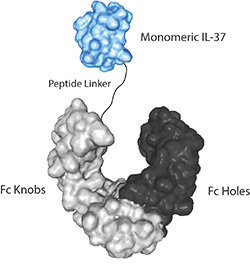IL-37 (human) (monomeric):Fc-KIH (human) (rec.)
| Code | Size | Price |
|---|
| AG-40B-0221-C010 | 10 ug | £370.00 |
Quantity:
| AG-40B-0221-3010 | 3 x 10 ug | £730.00 |
Quantity:
| AG-40B-0221-C100 | 100 ug | £1,510.00 |
Quantity:
Prices exclude any Taxes / VAT
Overview
Host Type: HEK 293 cells
Regulatory Status: RUO
Target Species:
- Human
- Mouse
Shipping:
BLUE ICE
Storage:
Short term storage:+4°C. Long term storage:-20°C.
Images
Documents
Further Information
Alternate Names/Synonyms:
IL-37 (human) (monomeric):Fc Knobs-into-Holes (human) (rec.); Interleukin-1 Family Member 7; IL-1F7; FIL1 zeta; IL-1X; Interleukin-1 Homolog 4; IL-1H4; Interleukin-1 zeta; IL-1 zeta; IL-1RP1; IL1F7; FIL1Z, IL1H4, IL1RP1
Concentration:
After reconstitution: for 10ug size: 0.1mg/ml, for 100ug size: 1mg/ml
EClass:
32160000
Endotoxin:
<0.01EU/ug purified protein (LAL test).
Form (Short):
solid
Formulation:
Lyophilized. Contains PBS.
Handling Advice:
After reconstitution, prepare aliquots and store at -20°C. Avoid freeze/thaw cycles. Centrifuge lyophilized vial before opening and reconstitution. PBS containing at least 0.1% BSA should be used for further dilutions.
Long Description:
Recombinant Protein. Human IL-37 (aa 46-218) (Delta5CysS-S and Y85A) (see reference: A. Bujotzek, et al. 2022) is fused at the C-terminus to a Fc (human) IgG1 (Knobs-into-Holes technology) (see reference: J.B. Ridgway, et al.; Protein Eng. 9, 617 (1996)). Source: HEK 293 cells. Lyophilized. Contains PBS. IL-37 (IL-1F7; IL-1H4) is an IL-1 family member that is expressed only in certain types of human organs and cells such as heart, thymus, testis, kidney, mononuclear cells (PBMCs) and dendritic cells. IL-37 is a soluble and secreted cytokine of 218 residues that shares the beta-trefoil fold common to IL-1 family cytokines. But IL-37 is an atypical member of the IL-1 family of cytokines as it functions to inhibit many of the major pathways of innate and adaptive immunity and inflammation. It binds to the interleukin-18 receptor (IL-18R) and its co-receptor SIGIRR. IL-37 is secreted as a full-length and as a processed form starting from amino acid Val46 and assembles into an activity-limiting dimer with a dimerization constant in the nanomolar range. IL-37 mutations that lock the cytokine into its monomeric conformation (e.g. Y85A and D73K) are more active at blocking inflammation than wild-type dimer-forming IL-37 in a broad range of in vitro and in vivo activity assays. IL-37 also inhibited Lipopolysaccharide (LPS)-induced immunological reaction and LPS-induced osteoclast formation and bone resorption. IL-37 (human) (monomeric):Fc-KIH (human) (rec.) (Prod. No. AG-40B-0221) is a new recombinant monomeric IL-37 produced in mammalian cells that has enhanced stability and activity compared to the classical human recombinant IL-37 produced in bacteria. This monomeric IL-37 protein is produced by using two different vectors, one encoding for the IL-37 (monomeric):Fc Knobs sequence (synthesizing a protein of 50kDa) and one encoding for the Fc Holes sequence (synthesizing a protein of 28kDa). Both vectors transfected into HEK293 cells produce both Fc molecules (Knobs-into-Holes technology; J.B. Ridgway, et al.; Protein Eng. 9, 617 (1996)) required for dimerization and for secretion of the final protein IL-37 (human) (monomeric):Fc-KIH (human) (rec.).
Molecular Weight:
~55kDa and 28kDa (SDS-PAGE); ~90 kDa (Monomer) (SEC)
NCBI, Uniprot Number:
NP_055254
Package Type:
Plastic Vial
Product Description:
IL-37 (IL-1F7; IL-1H4) is an IL-1 family member that is expressed only in certain types of human organs and cells such as heart, thymus, testis, kidney, mononuclear cells (PBMCs) and dendritic cells. IL-37 is a soluble and secreted cytokine of 218 residues that shares the beta-trefoil fold common to IL-1 family cytokines. But IL-37 is an atypical member of the IL-1 family of cytokines as it functions to inhibit many of the major pathways of innate and adaptive immunity and inflammation. It binds to the interleukin-18 receptor (IL-18R) and its co-receptor SIGIRR. IL-37 is secreted as a full-length and as a processed form starting from amino acid Val46 and assembles into an activity-limiting dimer with a dimerization constant in the nanomolar range. IL-37 mutations that lock the cytokine into its monomeric conformation (e.g. Y85A and D73K) are more active at blocking inflammation than wild-type dimer-forming IL-37 in a broad range of in vitro and in vivo activity assays. IL-37 also inhibited Lipopolysaccharide (LPS)-induced immunological reaction and LPS-induced osteoclast formation and bone resorption. IL-37 (human) (monomeric):Fc-KIH (human) (rec.) (Prod. No. AG-40B-0221) is a new recombinant monomeric IL-37 produced in mammalian cells that has enhanced stability and activity compared to the classical human recombinant IL-37 produced in bacteria. This monomeric IL-37 protein is produced by using two different vectors, one encoding for the IL-37 (monomeric):Fc Knobs sequence (synthesizing a protein of 50kDa) and one encoding for the Fc Holes sequence (synthesizing a protein of 28kDa). Both vectors transfected into HEK293 cells produce both Fc molecules (Knobs-into-Holes technology; J.B. Ridgway, et al.; Protein Eng. 9, 617 (1996)) required for dimerization and for secretion of the final protein IL-37 (human) (monomeric):Fc-KIH (human) (rec.).
Purity:
>95% (SDS-PAGE)
Sequence:
Human IL-37 (aa 46-218) (Delta5CysS-S and Y85A) (see reference: A. Bujotzek, et al. 2022) is fused at the C-terminus to a Fc (human) IgG1 (Knobs-into-Holes technology) (see reference: J.B. Ridgway, et al.; Protein Eng. 9, 617 (1996)).
Source / Host:
HEK 293 cells
Specificity:
Works in human and mouse models.
TAGs:
Fc
Transportation:
Non-hazardous
UNSPSC Number:
12352202
Use & Stability:
Stable for at least 1 year after receipt when stored at -20°C. Working aliquots are stable for up to 3 months when stored at -20°C.
References
Protein engineering of a stable and potent anti-inflammatory IL-37-Fc fusion with enhanced therapeutic potential: A. Bujotzek, et al.; Cell Chemical Biol. 29, 1 (2022)



